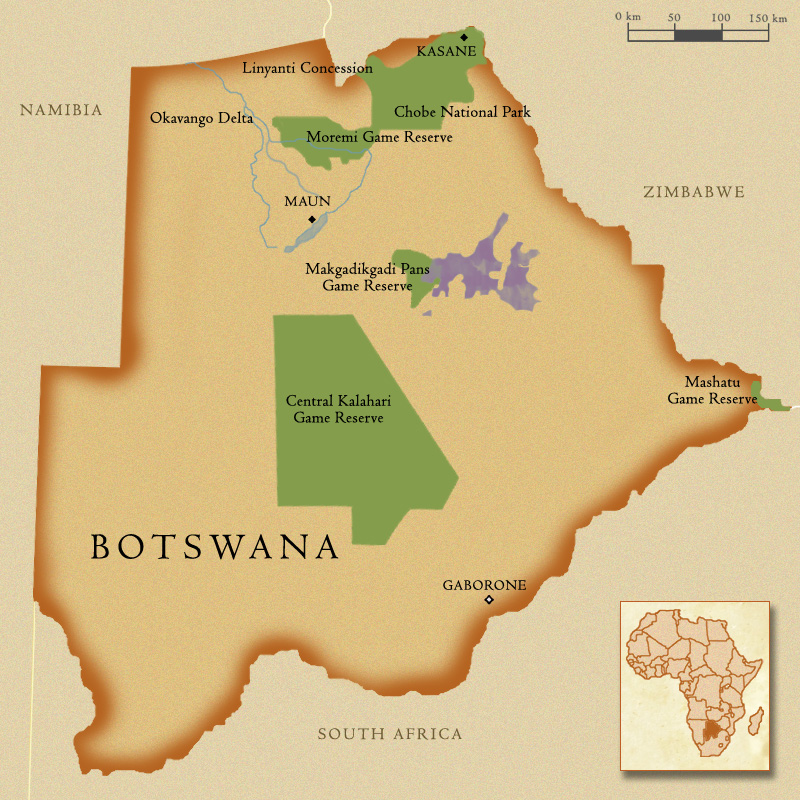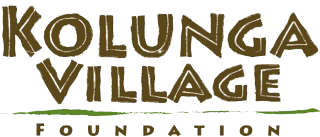Botswana Quick Facts
 Size: 581,730 square miles
Size: 581,730 square miles
Population: 2,065,398
Capital: Gaborone
Climate: Semiarid; warm winters and hot summers
Economy: Mining, tourism, ranching
Language: English, Setswana
Currency: Pula
Timezone: EST +7
Visa: Yes
Best Time to Visit: January February May June July August September October November December
Botswana offers so much in the way of wildlife and culture, as well as fascinating attractions, that the best way to understand the destination is the break it down by it's regions.
First up is the Southern Region, which is how how visitors enter Botswana. It features the Botswana's capital city ofGaborone, with its museums, nearby diamond mines, government center, and nightlife. Lobatse is the border town through which most visitors enter Botswana from South Africa. There also are a few game reserves within driving distance from Gaborone, including Mokolodi, Gaborone and Manyelanong.
Arguably the most popular and geographically dramatic area of Botswana is the Moremi and Okavango Region. Maun is the main city here and it is the primary point for arrival and departure by air. The Okavango Delta is the world's largest inland delta and is one of Africa's most fascinating - and best known - safari areas. A safari in the Okavango Delta' is one of Africa's top big game safaris. Day and night game drives, walking safaris and mokoro ride are all available in this lush water-wilderness of papyrus swamps, shallow reed-beds and floodplains, dotted with islands and laced with a network of channels. A patchwork of private reserves offer small, and often, luxury camps with exclusive game-viewing safaris, making this a wonderful place to truly relax and rejeuvenate. Moremi Game Reserve is a large protected wildlife area of 3,000 sq km (1170 sq mi) that includes approximately 20% of the Okavango Delta. Its wide range of habitats -- from seasonal and permanent wetland and reed beds to forest and savannah woodland - supports an astounding range of fauna - from exotic birds, zebras, buffalo, wildebeest and giraffes to hippos and lions. To protect the environment, there are very few lodges and camping sites; the majority of lodges and camps ring the reserves.
Most visitors to Botswana include the Chobe Region on their itinerary because of the Chobe River. Chobe National Park has one of the largest game concentrations on the Africa continent, and is best known for its spectacularly large elephant population and close proximity to Victoria Falls. Huge amounts of big game congregate beside the Chobe Riverfront, in the north of the park, as the dry season progresses. The Chobe riverfront is easily accessible, and with the lure of excellent game watching both on and beside the river, the well frequented areas can become a bit crowded. Further south is the less populated Savute, a magical spot for mobile safaris in addition to its camps and lodges. The Savute is a dramatic area to see high concentrations of elephant and lions, as well sighting of all the other major predators; the endangered wild dog, leopard, cheetah and the hyena. It is also renowned for its excellent birding during the summer months as well as being home to some very rare rock paintings drawn by the early San Bushmen, who once inhabited the region. The Linyanti Wildlife Reserve is another big game area located by the Kwando-Linyanti rivers, where the marsh subsides into lagoons and steadily flowing rivers with riverine forests leading to open grasslands, and dry inland wooded areas. The Linyanti Reserve is highly populated with animals particularly in the dry winter months: huge herds of elephants, thousands of zebra, the particularly beautiful sable and roan antelopes, red lechwe and the aquatic sitatunga antelope, and predators - lion, leopard, cheetah, wild dog and hyena. Birdlife is abundant here and particularly vocal with a magnificent dawn chorus. Daytime noises include incessantly grunting hippos and trumpeting elephants, while the night brings roaring lions and laughing hyenas. Kasane is the main city in this region.
In the Kgalagadi Region, the Central Kalahari Game Reserve is an ultimate remote safari destination -- and at its best when visited on an intrepid mobile safari in the early months of the year when the beautiful valleys between dunes become lush with vegetation, attracting thousands of springbok and gemsbok. You'll also find good numbers of ostrich and giraffe, herds of wildebeest, excellent cheetah and the Kalahari's famous black-maned lions. Less easy to spot are the leopard and brown hyena -- common residents of the Central Kalahari. Overall, this is a very arid region -- desert-like in the summer, cold in the winter. Ghanzi is the main city for this region. One of the top attractions for visitors is visiting a village of the San bushmen with a guide and observing their unique way of life. The Kgalagadi Transfrontier Park in the Southern Kalahari, straddles Botswana and South Africa and is the first formally declared Transfrontier Park in Africa - being designed to serve as a model for conservation in the 21st Century. On the Botswana side is the Mabuasehube ('red earth' in Segologa) area of the Park; one of the world's largest and most pristine wildernesses with shifting sand dunes and herds of Eland and Gemsbok.
Nata is the main city in the Makgadikgadi and Nxai Pans Region. The Magkadigkadi Salt Pans are the largest salt pans in the world, often likened to a moonscape. During the wet season, huge numbers of both greater and lesser flamingos come to the Magkadigkadi to feed and breed in the shallow saline water located on the pans, and the grasslands at the perimeter of the pans support one of the largest migrations of zebras. However, people visit this vast, wild, completely untamable area to experience its seemingly endless stark and mysterious beauty. This area is popular for quad biking and mobile camping safaris. Located only two hours drive from Maun, Nxai Pan is one of the more easily accessible of Botswana's parks. Yet it still remains relatively untouched and seemingly remote. It contains some spectacular scenery and has some of the northern Kalahari's best game viewing. It is one of the few places in Africa where you can find springbok and impala grazing side by side. Kudu are also common, as are the diminutive steenbok. During the wet season the zebra migration of the Magkadigkadi often spills over into the Nxai Pan area. Mobile camping safaris, self-drive camping are popular, and one eco-lodge, Nxai Pan, is now operating inside the national park.
The Eastern and Central Region is home to mostly rural and agricultural activity, however there are several attractions for visitors. The Tuli Game Reserve in the extreme east of Botswana is situated between the Limpopo, Motlouse and Shashe rivers and contains an abundance of wildlife, a profusion of birds and a breathtaking diverse wilderness of savannah, riverine forests, open plains and sandstone outcrops. A wonderful location for excellent game drives as well as adventure activities such as mountain bike safaris, horseback safaris, and hot air ballooning. Francistown is the main city for this region.


